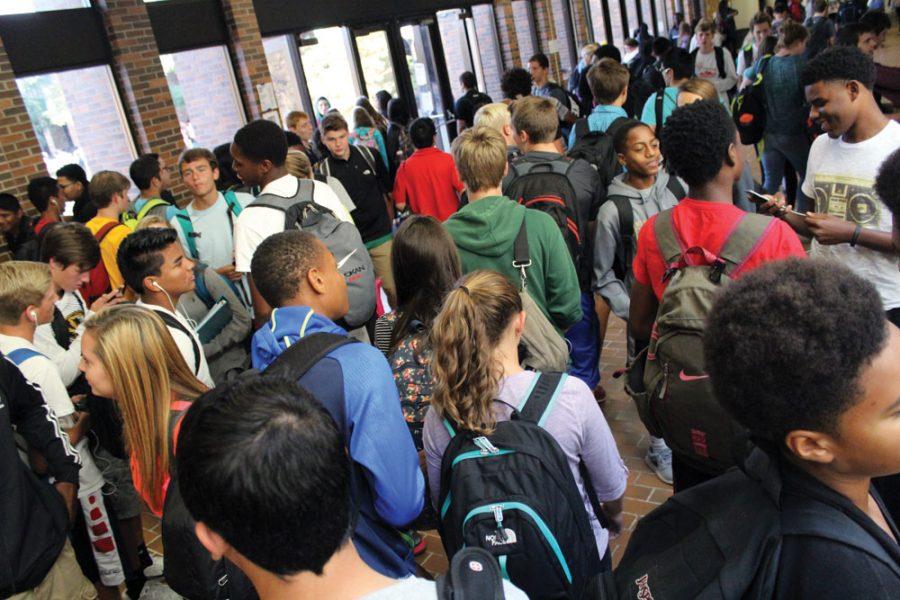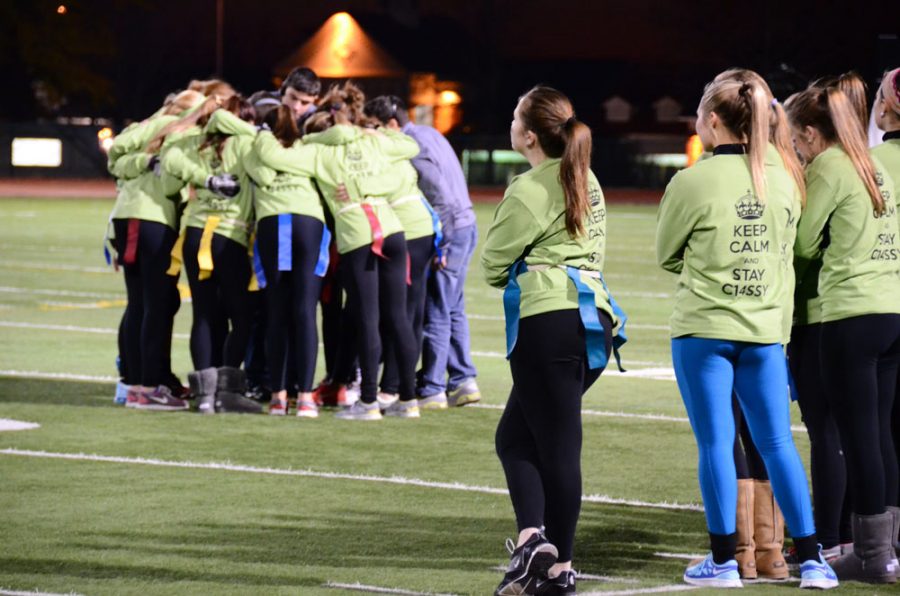Students mingle in the main commons after school. Crowded areas such as this one have become more common, as the unexpected addition of freshmen have added to the school’s population.
With nearly 50 more freshmen alone enrolled this year than guidance had originally anticipated, many students have noticed larger class sizes and more crowded hallways during passing periods this year than there were last year.
Much of this, Director of Guidance Betsy Jones said, is due to students transferring over from other CPS high schools or moving into the RBHS district.
“We were anticipating about 450 freshmen and we currently have about 501,” Jones said. “When we started school we had about 520 [students], but that was really because we don’t drop students until we have another school requesting records, so once we get those record requests we drop [students].”
While Jones said not all classes are experiencing the same overcrowding issues, certain classes, such as Algebra 1, filled quickly from the unexpected number of freshmen attending RBHS this year.
“Algebra 1 is the big conundrum right now, so we’re considering opening a couple new sections of Algebra I and moving some students to alleviate large class sizes,” Jones said. “In the spring, when we looked at our numbers, we anticipated our Algebra I classes to be about 20 to 22 students, and right now they’re 27, 28, 29 [students], so that’s really the biggest conundrum that we’ve had so far.”
Along with Algebra 1, Jones said Freshmen Advisories, Civics Studies classes and Physics classes are also generally overcrowded, as they are other freshman-level classes required for every student.
[spoiler title=”Notes” open=”yes” style=”simple” icon=”chevron”]RBHS Student Population Over the Years: 2011-2012: 1722 Students
2012-2013: 1840 Students
2013-2014: 1884 Students
2014-2015: 2208 Students
[/spoiler]
Junior Grace Maledy has noticed the larger population. She said though most of her classes seem to have normal amounts of students, she has noticed a slightly larger class size in her AP US Studies class and more crowding in the halls during passing periods, particularly in comparison to the past two years she has attended RBHS.
“There is no doubt in my mind that the student population is growing at Rock Bridge,” Maledy said. “I had never had a problem with it my freshman and sophomore year, but this year it’s absolutely crazy. There isn’t going to be anymore room at our school to fit all of the kids coming from the middle schools.”
The class sizes aren’t only affecting students. AP Language and Composition teacher Deborah McDonough said senior English and Language Arts classes also have larger class sizes this year. These overfilled classes can make teachers’ jobs harder, particularly when trying to make sure all students understood the necessary themes of the lesson.
“No matter what discipline you teach, I believe most educators would say that the number of students in a course affect what can be accomplished — both positively and negatively,” McDonough said. “Smaller classroom size allows for more individualized attention. Larger classroom size can sometimes limit what can be accomplished.”
Specifically for English classes, McDonough said larger classes makes grading work harder and more time consuming, causing issues down the road when teachers are unable to give students better feedback in the same amount of time as they would be able to with smaller class sizes.
“As an English instructor, there is always the issue of grading essays. Providing detailed feedback to improve a student’s writing is very important. It is one of the challenges that gives me the most stress,” McDonough said. “The majority of my students are very appreciative and quite grateful for the feedback.”
Even some freshmen have taken notice of the larger population. Freshman Leo Zhuang, who took math classes at RBHS while still at Gentry Middle School last year, said the hallways at RBHS this year do seem to be more crowded than they were before, though he doesn’t necessarily notice larger class sizes being an issue.
“So far, I haven’t felt like the classes have been crowded. I did come to Rock Bridge last year for classes, and there has been a significantly larger crowd in the hallways,” Zhuang said. “I used to be able to just walk through the main commons pretty easily, weaving in and out. But now, I have to wait and let crowds pass before getting through.”
Though there are many small inconveniences in having a larger student population, Maledy said she worries there will be long-term effects in scheduling if this increasing trend in population continues.
“I’m glad that Rock Bridge has a large student population, but I feel like we have to draw a line on how many students we can actually fit in the building,” Maledy said. “When my brother went to high school he was able to get whatever classes he wanted as a junior, but now that isn’t happening because of how many students we have now.”
Zhuang, however, said having a larger number of students at RBHS isn’t necessarily a bad thing. In fact, he said a larger student population can help new students feel more included and allow for a greater sense of community between certain groups of students.
“With a larger class, there are more people to meet, and more opportunities for socializing. With more people however, it is easy to get lost and forgotten in the crown. Sometimes, it feels like you are just another person — another fish in the sea,” Zhuang said. “The number of students at Rock Bridge feels appropriate. It’s a big school, and it feels nice to have a busy school. It makes the school feel alive.”
Even so, McDonough said student population is only one of the factors that should be considered when looking at one’s academic atmosphere as a whole.
“It is important to remember that the number of course offerings is based on what students choose for their schedule,” McDonough said. “No matter the class size, teachers work long hours to ascertain all students receive an exceptional educational experience at RBHS. Administrators at all levels as well as all teachers and all students must work together for this to happen.”
Do you think the school is too crowded?
How do you adjust to an unexpected change?
Categories:
Students crowd hallways, spark school wide dilemma
September 29, 2015
0
More to Discover



















































































